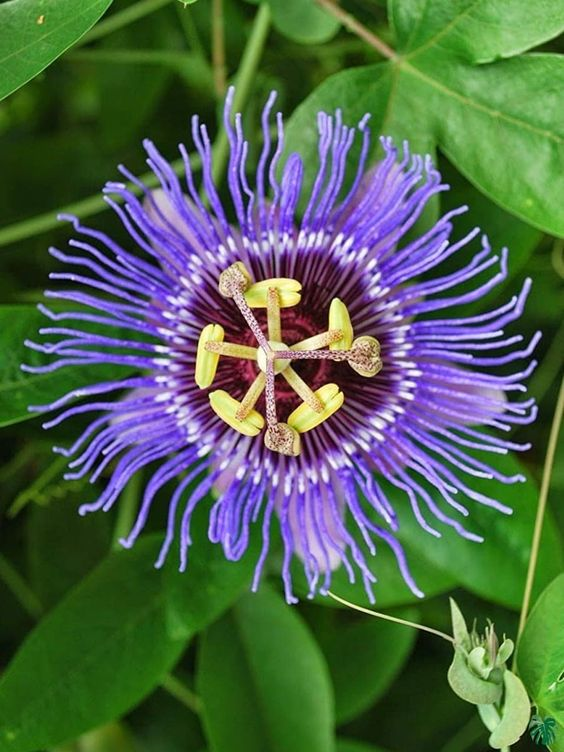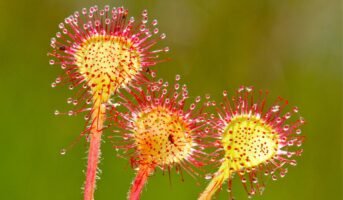Passiflora foetida, commonly known as stinking passionflower, is a genus of passion blossoms from the southern-western provinces of the USA (southern Texas and Arizona), Mexico, the Caribbean, Central America, and most of South America. It has been initiated in tropical regions worldwide, including Southeast Asia, South Asia, Hawaii, Africa, and The Maldives. Like the other genus’s representatives, it is a crawling vine that produces edible fruit. The particular epithet, foetida, implies “reeking” in Latin and refers to the intense and unpleasant smell emission by these plants.
Passiflora foetida: Key facts
| Common Name | stinking passionflower, love-in-a-mist, stone flower, wild water lemon |
| Scientific Name | Passiflora foetida |
| Soil | Acidic soil |
| Temperature | 16°C |
| Water | Moderate |
| Sunlight | Plenty |
| Blooming time | More than one month |
| Type | Passion Flower |
Passiflora foetida: Features
- The stems are slender and sinewy, with sticky yellow hairs covering them. Older stems turn woody.
- The leaves are viscid-hairy and have three to five lobes. When squashed, these leaves emit a strong odour that some people find unpleasant.
- The flowers are five to six cm in diameter and white to opaque cream in colour. The fruit is spherical, two to three cm in diameter, pale yellow to red once fully mature, and includes multiple black seeds ingrained in the pulp; birds eat the fruit and disperse the seeds.
- Passiflora foetida attracts insects with its bracts, emitting thick mucus containing digestive enzymes.
Passiflora foetida: How to grow?

Source: Pinterest
Water
There are many genera and variations of stinking passionflower, but most are sensitive to cold and should be brought inside if the heat in your garden falls below ten °C in the winter. The plant also requires consistent watering to thrive; it does not withstand harsh and necessitates 2.5 – 4 cm of water once a week.
Sunlight
To develop and blossom appropriately, a stinking passionflower requires a lot of sunlight. A minimum of four hours of direct sunshine with some midday shade is ideal. To maintain adequate growth in colder areas or indoors, including at least six-hour shifts of direct sunlight.
Soil
Stinking passionflower is not picky about soil type, but it requires consistent humidity and well-drained soil, which can be challenging. To enhance sewage and humidity regulation, you can always add organic compost to the soil. The plant grows best in mildly acidic soil with a pH of 5.0-6.0.
Propagation
Take a 10 – 15 cm long cutting to propagate your stinking passionflower. Remove the bottom leaf, dip it in the growth hormone, and place it in a moist soil-filled pot. Encompass with polycarbonate and keep in the shade until the root has formed. This takes around a month on average.
Passiflora foetida: Maintenance
Planting
The stinking passionflower can be sown as a small plant or grown from seed. This can take upwards of a month, and you must wait until seedlings have evolved two sets of leaves before implanting them. Planting is most effective in the spring or autumn while the soil is still hot. Choose a sunny spot in your garden protected from strong winds and water thoroughly after planting.
Pruning
The stinking passionflower is a climber that does not necessitate pruning to develop, but it will produce a fuller plant if you do. Pruning is most effective in the late winter or the early spring. Flowers do not require deadheading; eliminate any killed plant parts and cut to improve shape. To avoid the transmission of diseases, use clean, pointed pliers and always sanitise your tools.
Reaping
Independent petals from your stinking passionflower can be trimmed off and used new or left to dry in the house. The fruit is prepared in midsummer to early autumn and ought to be selected when it is doughy and has a deep yellow, red, or purple colour, based on the variety.
Fertiliser
The stinking passionflower is a voracious feeder. It will reap plenty of advantages from the use of quality fertilisers regularly, satisfying you with lovely blooms. Use a high-quality general-purpose fertiliser with a well-balanced nitrogen, phosphorus, and sodium ratio. Begin fertilising in the spring, just as new shoots would seem, and continue every six days until the fall.
Passiflora foetida: Benefits

Source: Pinterest
Mild sedative
Passiflora foetida is a tranquilliser and anxiolytic. The sedative effects of this plant help to alleviate both insomnia and anxiety. This means it is also efficient in lowering anxiety and having calming and sleep-inducing properties.
Muscle relaxant
Conventional facts support its activity as an anti-inflammatory agent, which means it lessens spasticity in muscle tissue. This is due in part to its relaxing impacts on the nervous system.
Cures various diseases
This species can be utilised to cure digestive issues such as dyspepsia and diarrhoea, as well as as an antiseptic and emmenagogue for anxious circumstances and spasms.
FAQs
Is Passiflora foetida poisonous?
Passiflora foetida has indeed been identified as a toxic plant by farmers in northeastern Brazil. A test with goats revealed that the cyanide in P. foetida ends up causing toxicity after the intake of leaf extract, especially during the dry season.
How should Passiflora foetida be consumed?
Both the foliage and unripe fruit of the plant contain cyanide. Although the ripe fruits are fleshy and sweet, the leaves and young shoots can be cooked to make them edible. The leaves can be turned into jelly.
Housing News Desk is the news desk of leading online real estate portal, Housing.com. Housing News Desk focuses on a variety of topics such as real estate laws, taxes, current news, property trends, home loans, rentals, décor, green homes, home improvement, etc. The main objective of the news desk, is to cover the real estate sector from the perspective of providing information that is useful to the end-user.
Facebook: https://www.facebook.com/housing.com/
Twitter: https://twitter.com/Housing
Email: [email protected]











